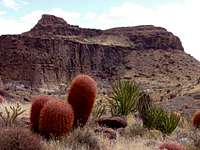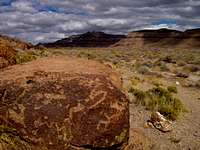|
|
Area/Range |
|---|---|
|
|
34.91100°N / 115.73°W |
|
|
Hiking, Mountaineering, Bouldering, Scrambling, Via Ferrata |
|
|
Spring, Summer, Fall, Winter |
|
|
Overview
Mojave National Preserve, at 1.6 million acres, is the third largest National Park Service managed area in the Lower 48; only Death Valley and Yellowstone are larger. It was set aside on October 31, 1994 as part of the California Desert Protection Act. This was the same legislation that changed Joshua Tree and Death Valley from National Monuments to National Parks. The Mojave National Preserve is a huge triangular shaped area bounded by I-15 to the north and I-40 to the south and it extends east from the Baker area all the way to the Arizona state line.The Mojave National Preserve encompasses a wide range of landscapes from granite mountains to volcanic cinder cones to limestone caves to sand dunes. Elevations range from 880’ near Baker to 7,492’ at the top of Clark Mountain. There is a huge variety of plant and animal life as three major desert ecosystems are present in the preserve; the Mojave, Great Basin, and Sonoran Deserts. From white fir atop the Clark Mountains and the New York Mountains down to Pinyon pine and juniper forests to Joshua Tree forests to cactus and creosote in the lowlands the plant life is very diverse. Kit fox, coyote, mule deer, bighorn sheep, desert tortoises and other reptiles, and many types of birds and small rodents call the Mojave National Preserve home.
There are lots of peaks to climb and endless areas to explore in Mojave National Preserve. Be sure to visit the National Park Service Website for more info!
Getting There
There are 6 freeway exits off of I-15 and I-40 that you can use to access the preserve. Fuel up on gas and bring plenty of food and water because services inside the Preserve are few!
Link to more detailed Mojave National Preserve Map
Red Tape
There is no entrance fee and no permits are needed for camping or hiking.Backpackers traveling on foot must camp at least 0.5 mile from any developed area or road and 200 yards from water sources.
Backcountry camping is limited to a 14-day stay.
Roadside car camping is permitted in areas that have been traditionally used for this purpose. Camping tramples vegetation; by picking sites that have already been used for camping, you help protect desert plants from further damage.
Not all sites can accomodate multiple vehicles; please don't enlarge sites.
Do not camp along paved roads or in day-use areas, and stay at least 200 yards from springs and other water sources.
Driving off of designated roads is illegal.
Camping
Hole-in-the-Wall Campground
Surrounded by sculptured volcanic rock walls, Hole-in-the-Wall Campground is at 4,400 feet elevation. It's a good base for hiking and exploring nearby Mitchell Caverns.
Facilities: vault toilets, picnic tables, fire rings, trashcans, drinkable water, dump station. No utility hookups. 35 campsites are large enough for motorhomes and trailers. Two walk-in tent sites are also available.
Fees: $12 per site per night, $6 for Golden Age/Access Passport holders.
Reservations: not accepted. Campsites available on a first-come, first-served basis. Campground rarely fills.
Mid Hills Campground
A fire swept through here in June, 2005, burning over much of the area. Unburned campsites are surrounded by pinyon pine and juniper trees. At 5,600 feet in elevation, Mid Hills Campground is much cooler than the desert floor below. The road to the campground is not paved and is not recommended for motor-homes or trailers.
Facilities: picnic tables, fire rings, vault toilets, trashcans, and drinkable water. 26 campsites.
Fees: $12 per site per night, $6 for Golden Age/Access Passport holders.
Reservations: not accepted. Campsites are available on a first-come, first-served basis. Campground rarely fills.
Black Canyon Equestrian & Group Campground
Located across the road from Hole-in-the-Wall Information Center.
Facilities: vault toilets, water, a picnic shelter with tables, fire ring, grill, corrals.
Fees: $25 per night for the group.
Reservations: call 760 928-2572.
You can also disperse camp and camp in backcountry areas
...see red tape section above
External Links
Mojave National Preserve Website
Mojave National Preserve Weather Forecast
Mojave National Preserve Natural Features, Plants, Animals, etc.
Hiking Trails and Routes
Providence Mountains State Recreation Area & Mitchell Caverns
February 2006 Trip Report
November 2007 Trip Report
November 2008 Trip Report
Suggested Books and Maps
Hiking California's Desert Parks by Bill Cunningham (Falcon Press)
Tom Harrison's Mojave National Preserve Map
Flowers, Shrubs, and Trees of the Southwest
Visitor Centers
Kelso Depot Visitor Center
Open every day except Christmas, 9 a.m. to 5 p.m. daily
Phone (760) 733-4456
Location: From Interstate 15, exit at Baker, California. Kelso is 35 miles south of Baker. From Interstate 40, exit on Kelbaker Road. Kelso is 22 miles north of I-40 on Kelbaker Road.
Exhibits: The renovated Kelso Depot is now the Visitor Center for Mojave National Preserve. Most of the former dormitory rooms contain exhibits describing various aspects of the surrounding desert, from tortoises to sand dunes to desert mining and ranching. The old baggage room, ticket office, and two dormitory rooms have been historically furnished to illustrate life in the depot in the first half of the twentieth century. A 12-minute film is shown in the theater.
Available Facilities: Restrooms, water
Hole-in-the-Wall Information Center
Open October through April: Wednesday through Sunday, 9:00 a.m. to 4:00 p.m. May through September: Friday through Sunday, 9:00 a.m. to 4:00 p.m.
Phone (760) 928-2572
Location: 20 miles north of Interstate 40 on Essex and Black Canyon Roads.
Special Programs: Saturday evening ranger talks and Sunday morning guided nature walks, staffing permitting, Fall and Spring.
Exhibits: basic orientation
Available Facilities: Water, restrooms, pay telephone. A ranger is on duty to help with trip planning. Free maps and brochures are available, and there is also a bookstore. A picnic area, trailhead, and campgrounds, and group campground are nearby.
Headquarters Office
Open All Year Monday through Friday, 8:00 a.m. to 4:30 p.m
Phone (760) 252-6100
Location: 2701 Barstow Road, Barstow, California. From Interstate 15, exit south on Barstow Road.
Exhibits: limited
Available Facilities: A ranger is on duty to help with trip planning.
Mary Beal
I picked up a booklet at the Hole-in-the-Wall Ranger Station while visiting the Mojave National Preserve last month. It is titled, “The Floral World of Mary Beal” and it was written by Lucile Weight in 1969. After reading it I was intrigued and have searched for more info on Ms. Beal on the internet but haven’t come up with much of anything. So I wanted to share what I know from the booklet.Mary Beal was born in Moline, Illinois and in 1900 her family moved to Riverside, CA. From 1906 to 1910 Mary worked in the Riverside Library and it was during this time that she formed a friendship with the famed naturalist-author John Burroughs while assisting him with reference materials. He had invited her to join him at his home on the Hudson River in New York but then Mary came down with pneumonia. On advice from her doctor she moved to the Van Dyke Ranch out in the Mojave Desert near Daggett, CA. She was supposed to stay there for only 18 months but found herself falling in love with the desert and she ended up spending the rest of her life out there.
Mary was fascinated with desert plants from the first time she saw them but learning about them was frustrating as she did not have any formal training beyond a high school botany course. When Willis Jepson’s “Manual of the Flowering Plants of California” was published in 1923 she used it, along with a dictionary, to identify plants.
I don’t know how Mary and Willis met, but they did sometime between 1923 and 1928. During flowering seasons he would come down from the University of California at Berkeley to visit her, and together they went on field trips and developed a warm personal friendship. Mary started sending him plant specimens as early as 1928 and he would identify them or confirm her identifications. Over the years she gave over 2000 herbarium specimens to the Jepson Herbarium, over half of these are part of the Jepson collections. The remainders, which were duplicates, have been sent to herbaria worldwide as examples of Mojave Desert flora. Many of these specimens are cited under her name now in the Jepson Manual.
Mary spent countless hours climbing the mountains in the Mojave; the Providence Mountains, the New York Mountains, the Ords, and Clark Mountain are all islands in the desert where a great variety of species can be found and where the flowering season is extended far beyond that on the desert floor. She would take on her excursions, along with her collecting paraphernalia, three cameras, each with its particular purpose in making photographic field records. One of her cameras belonged to an astronomer at Mt. Wilson: it was the same one that had been used to record Halley’s Comet. Since this was long before color film was available, Mary hand-colored many of the photographs she took.
As a result of her dedication and hard work, many people became acquainted with desert flowers through the articles and photos she had published in Desert Magazine. As a tribute to her work there is now a nature trail with her name at Mitchell Caverns State Reserve.
If there’s anyone out there who knows more about Mary Beal or how she met Jepson, will you let me know? Thanks :)





